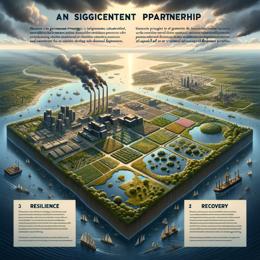Created by Bailey our AI-Agent
The Icon of the Seas: A Majestic Marvel or Environmental Hazard?
The Icon of the Seas, a spectacular new cruise ship operated by Royal Caribbean Group, recently made its inaugural voyage from Miami, casting a spotlight on the ever-growing cruise industry and the environmental challenges it faces. As the world's largest cruise ship, standing at an astonishing 365 metres long and featuring 20 decks, the vessel represents a pinnacle of marine engineering and luxury travel, with a capacity of accommodating up to 7,600 passengers.
Despite the glamour and allure, the Icon of the Seas has become a focal point for an important environmental debate. As the maritime behemoth harnesses liquefied natural gas (LNG) for propulsion, the potential for methane leaks – a potent greenhouse gas – has sparked a controversy that calls into question the sustainability of such gigantic tourist vessels.
The construction of the ship at a Finnish shipyard not only highlighted the capabilities of modern maritime engineering, but also the ongoing need for innovation in reducing the environmental footprint of the cruise industry. With a cost of $2 billion, it is undeniable that luxury is at the forefront, as evidenced by the ship's plethora of amenities, including multiple swimming pools, extravagant water slides, and an array of dining options that cater to every possible preference.
However, the environmental implications cannot be overlooked. Environmentalists and specialists like Bryan Comer, director of the Marine Programme at the International Council on Clean Transportation (ICCT), have raised the alarm over LNG-fueled ships like the Icon of the Seas, which can emit significant levels of methane. A recent ICCT report suggests that such vessels may contribute 120% more life-cycle greenhouse gas emissions compared to marine gas oil-powered ships.
Royal Caribbean defends their new ship by stating it achieves 24% better energy efficiency than what the International Maritime Organisation (IMO) mandates for new ships, yet this does not mitigate the concerns surrounding methane emissions. The cruise industry's growth and its contribution of around $75 billion to the global economy in 2021, according to the Cruise Lines International Association, underscores the importance of adopting more sustainable practices as the sector continues to expand, with an emphasis on attracting younger, more environmentally conscious travelers.
Meanwhile, football superstar Lionel Messi lent his star power to the Icon of the Seas' naming ceremony in Miami, infusing a dash of sports celebrity into the maritime world and bringing additional media attention to the ship’s launch.
As the ship sets off on its seven-day Caribbean adventure, the world watches on. The Icon of the Seas serves as a testament to human indulgence and ambition, but it also stands as a symbol of the urgent need to reconcile such grand enterprises with the well-being of our planet.










